Behind The Lens: Shooting Watches With The Hasselblad X1D-50C
by GaryG
Thanks to some great instruction and lots of practice, my watch shooting has made some pretty good progress since my first online photo post years ago, an image of a Reverso Art Deco that one forum member described as “the worst photo of a nice watch I have ever seen.”
Of course, equipment and processing software have played important roles as well! While it’s a pet peeve of shooters the world over to hear the remark “That’s a great picture – you must have a really nice camera!” it is nonetheless true that a practiced photographer can achieve different (and in my view, better) results with a camera that’s ideally suited to the objective and situation than with more rudimentary equipment.
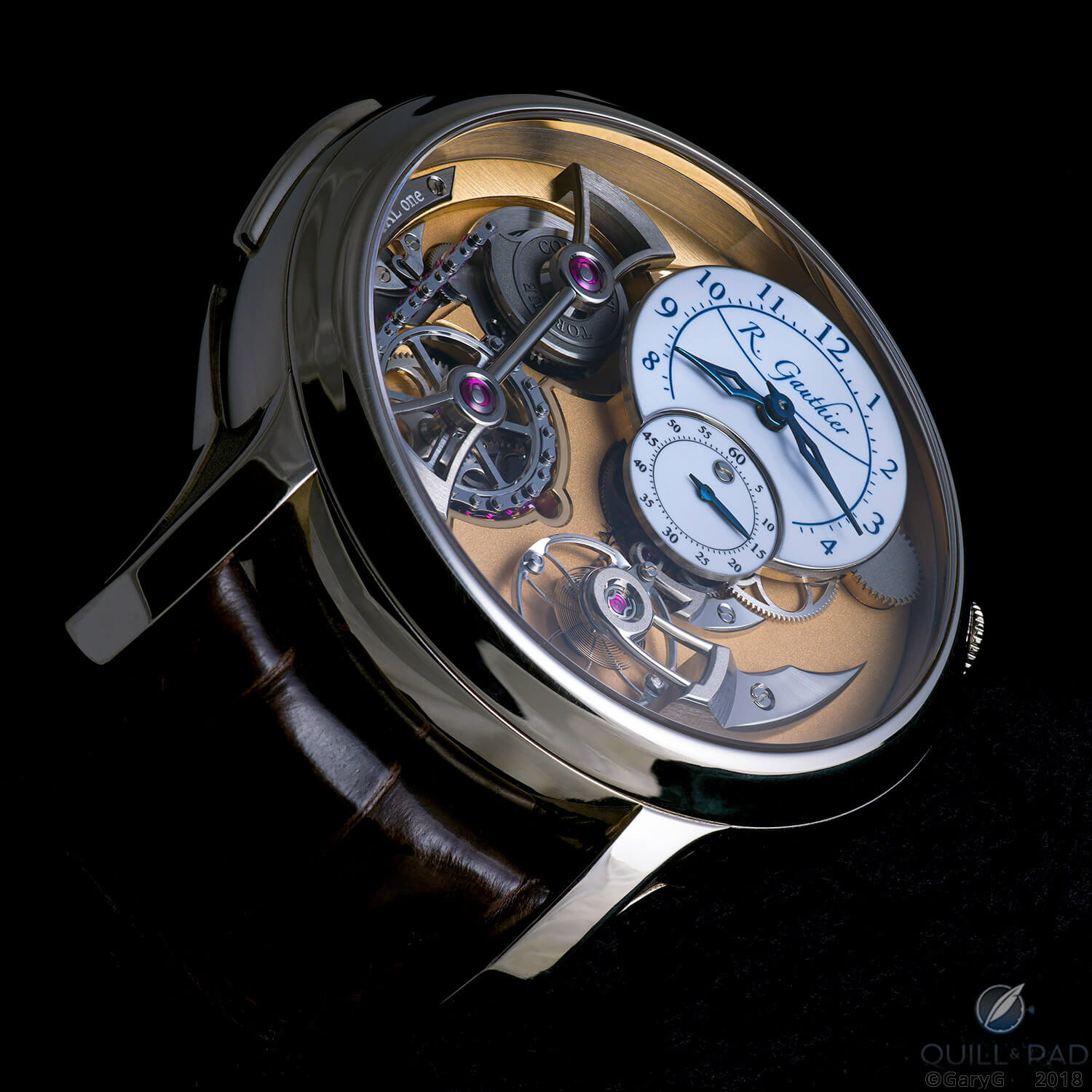
Light, subject, composition, camera: Romain Gauthier Logical One as captured with the Hasselblad X1D
For many years, my weapons of choice in the light tent realm had been Nikon’s top “prosumer” DSLRs and macro lenses, starting with the D700 and 105 mm macro and then moving to the D800e and D810 with the 85 mm PC-E “tilt-shift” lens.
Suffice it to say that the Nikon is an excellent tool: just take a look at this image of my Audemars Piguet Equation of Time watch, a piece that is extremely hard to capture due to its dark dial, shiny bezel, and fairly reflective crystal.
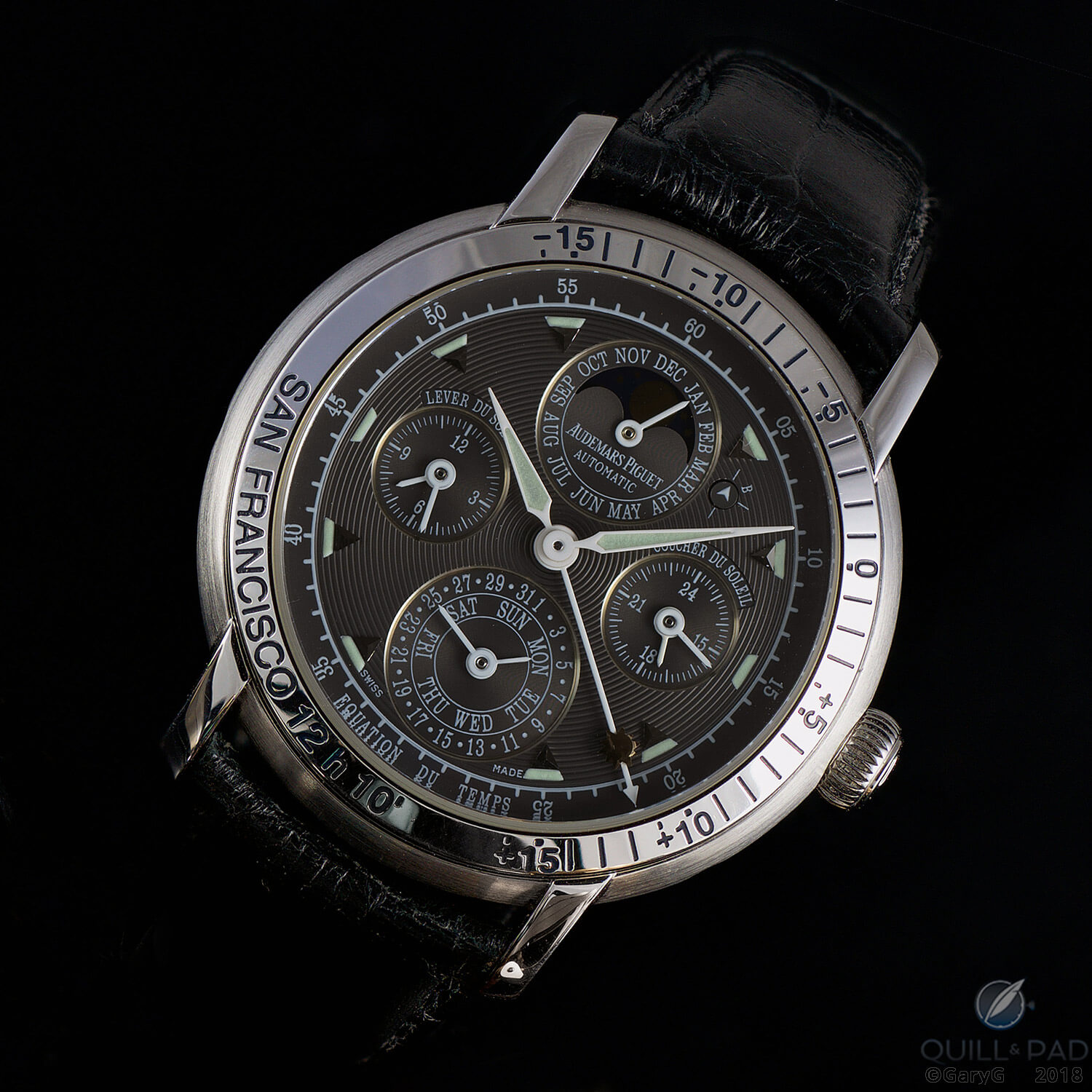
The author’s Audemars Piguet Jules Audemars Equation of Time shot with the Nikon D810
Discovering medium format
I’d ordered a Hasselblad X1D at launch mid-2016, and after an eight-month delay finally received it just in time to use it for some candid portraits during Baselworld 2017.
I’d never shot a medium-format camera before, and the resolving power, color rendering, and ability seemingly to wrap light around a subject like Quill & Pad colleague Joshua Munchow (below) completely blew me away. So when Hasselblad announced that it would be offering a 120 mm macro lens for the X1D, I was among the very first to sign up.
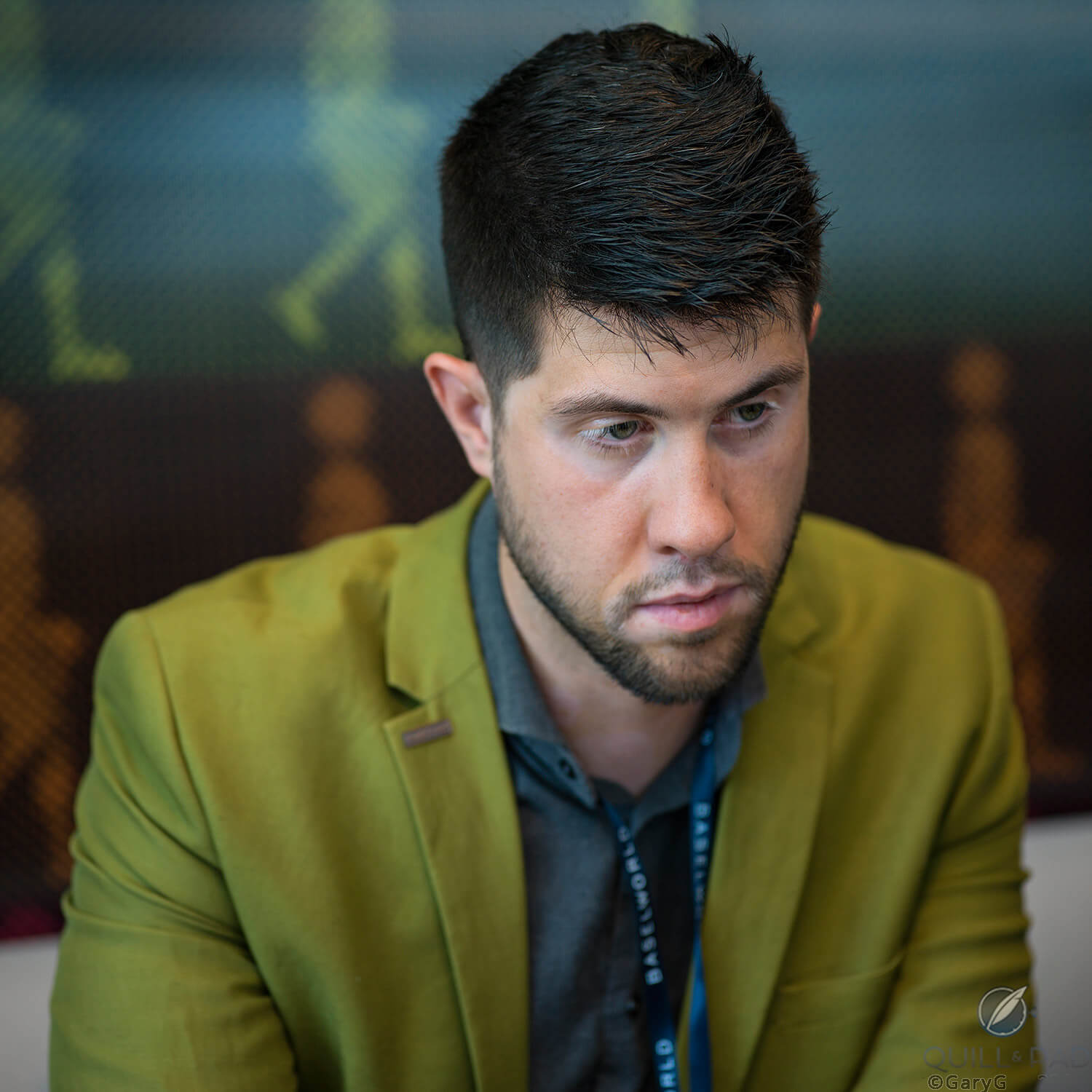
Candid portrait of Quill & Pad’s Joshua Munchow with the X1D, 2017
Fast forward several more months and the package containing the XCD120 3.5 macro lens finally arrived, sending me immediately to the light tent with one of my favorite photographic subjects, the mighty Double Split from A. Lange & Söhne.
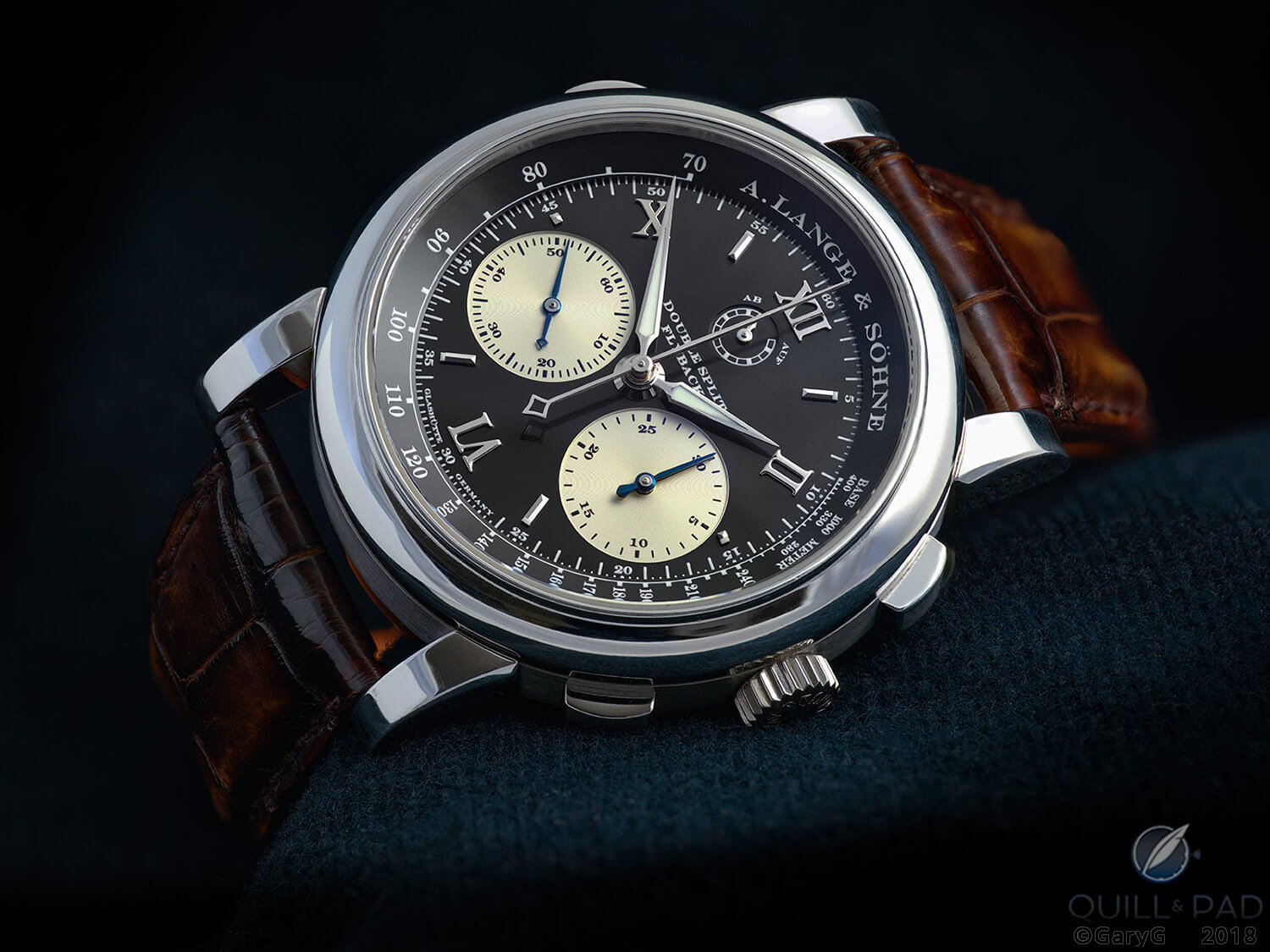
Love at first shot: A. Lange & Söhne Double Split captured with the Hasselblad X1D
From the very first shots, the great strengths of the X1D as a camera for watch photography were apparent. Perhaps at the top of the list is the accuracy with which the X1D captures colors; in the shot of the Double Split above you see the true black color of the dial, the pure and bright color of the platinum and its contrast with the slightly yellow German silver subdials, the very slight greenish cast of the LumiNova on the hands and markers, and the distinct blue of the hands.
And look at the colors of that strap! In this image, you can really see the color variations of the Santoni strap that I wear with this watch. It’s a bit amusing to me the number of comments I receive on my Hasselblad shots about how good the straps look; if I owned a strap company, I think I’d insist that all product photography be done with this camera.
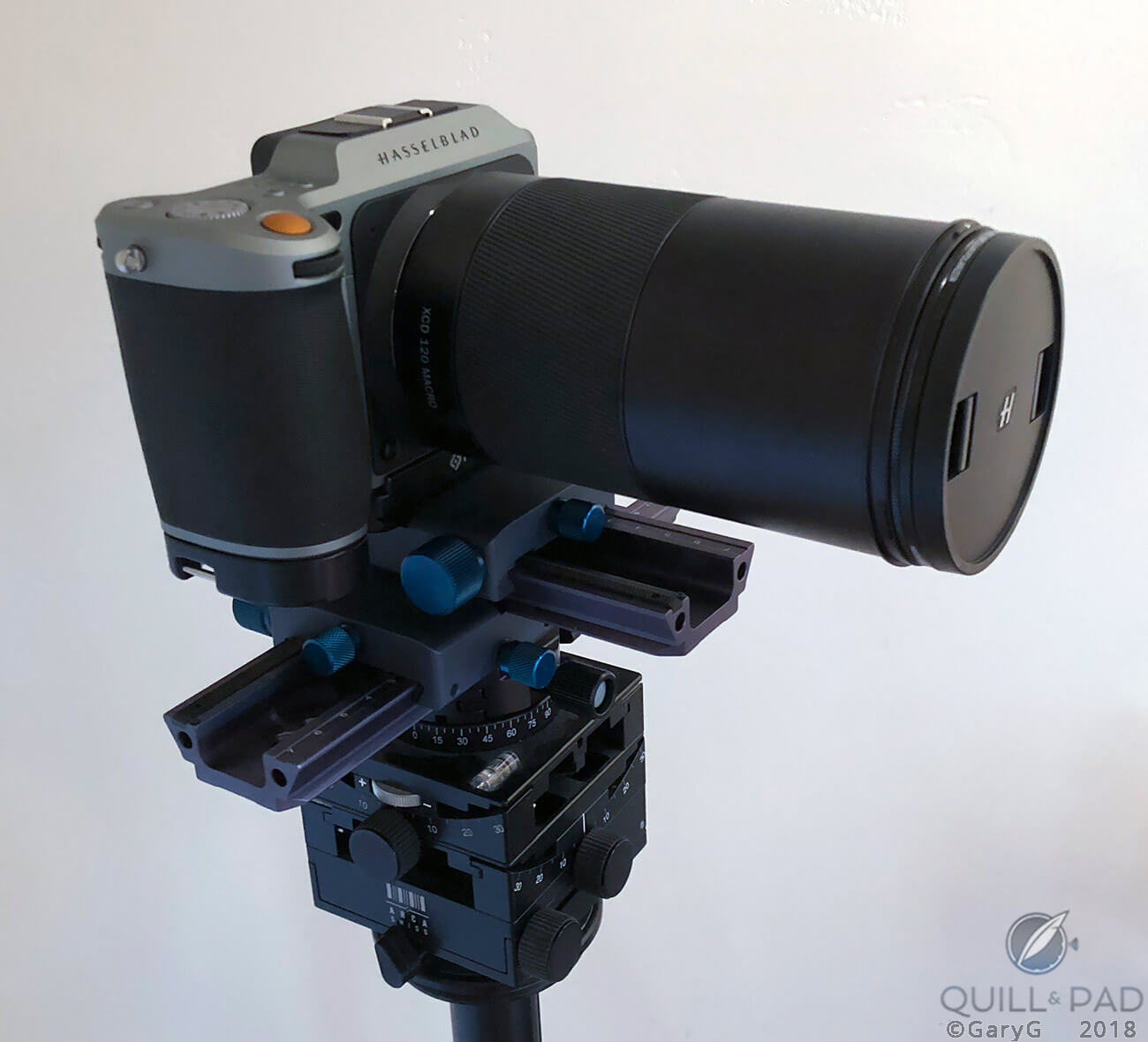
A bit slow to start: Hasselblad X1D with XCD120 macro lens
As with many good things, however, there is a price to be paid: each X1D’s color-sensing characteristics are individually tuned at the factory and incorporated in a boot-up file that takes several seconds to execute when the camera starts up, so there’s none of the instant-on-and-shoot convenience of the Nikon. For product photography this isn’t a big deal, but “in the wild” it can seem to take forever for the camera to be ready to fire on initial startup.
Once I set that minor annoyance aside, the other strengths of the camera rapidly became evident. As with the image of the Double Split, the color rendering in the photo of the F.P. Journe tourbillon below is just right: you can clearly tell, for instance, that while the case is platinum the crown is white gold.
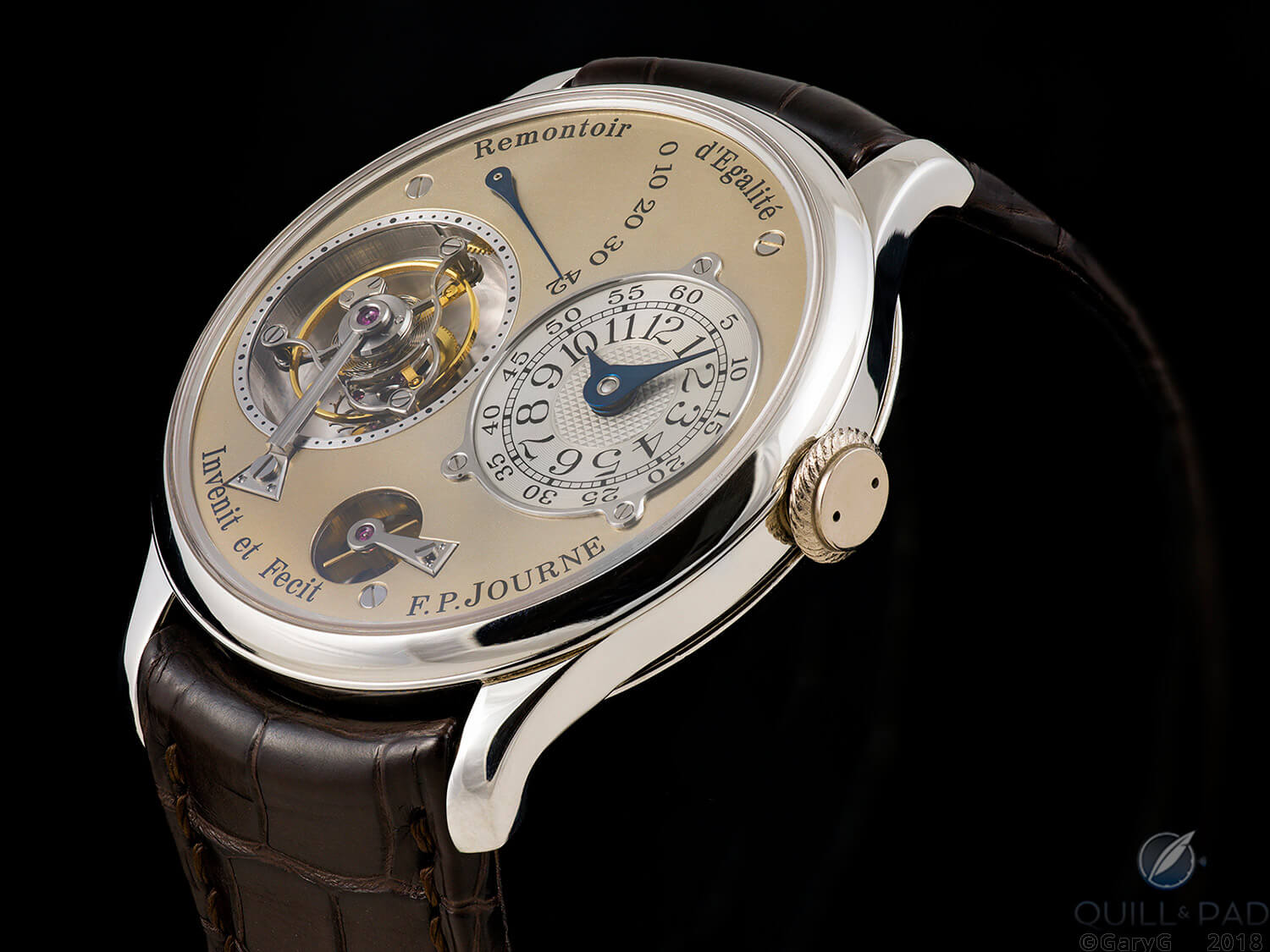
Color and light: F.P. Journe Tourbillon Souverain shot with the Hasselblad X1D
But there’s more: while in the published specifications the dynamic range of the Hasselblad is virtually identical to the Nikon’s, in real use the X1D seems a full step ahead. In my experience, bright areas of an image are far less prone to blowing out, and the dark zones don’t fall into blackness. I’ve long struggled with making dark straps visible against the black background that I favor, but with the X1D it’s almost like being able to see in the dark.
You can see the same strength in action if you scroll back up to the Double Split image: with most cameras the black dial would appear a uniform inky black, but in the shot above you can see the play of light across the surface.
The ability to see into the shadows also helps when you’re shooting a watch like the A. Lange & Söhne Pour le Mérite Tourbillon and want to provide a view of the fusée and chain and tourbillon cage as seen from the back of the watch.
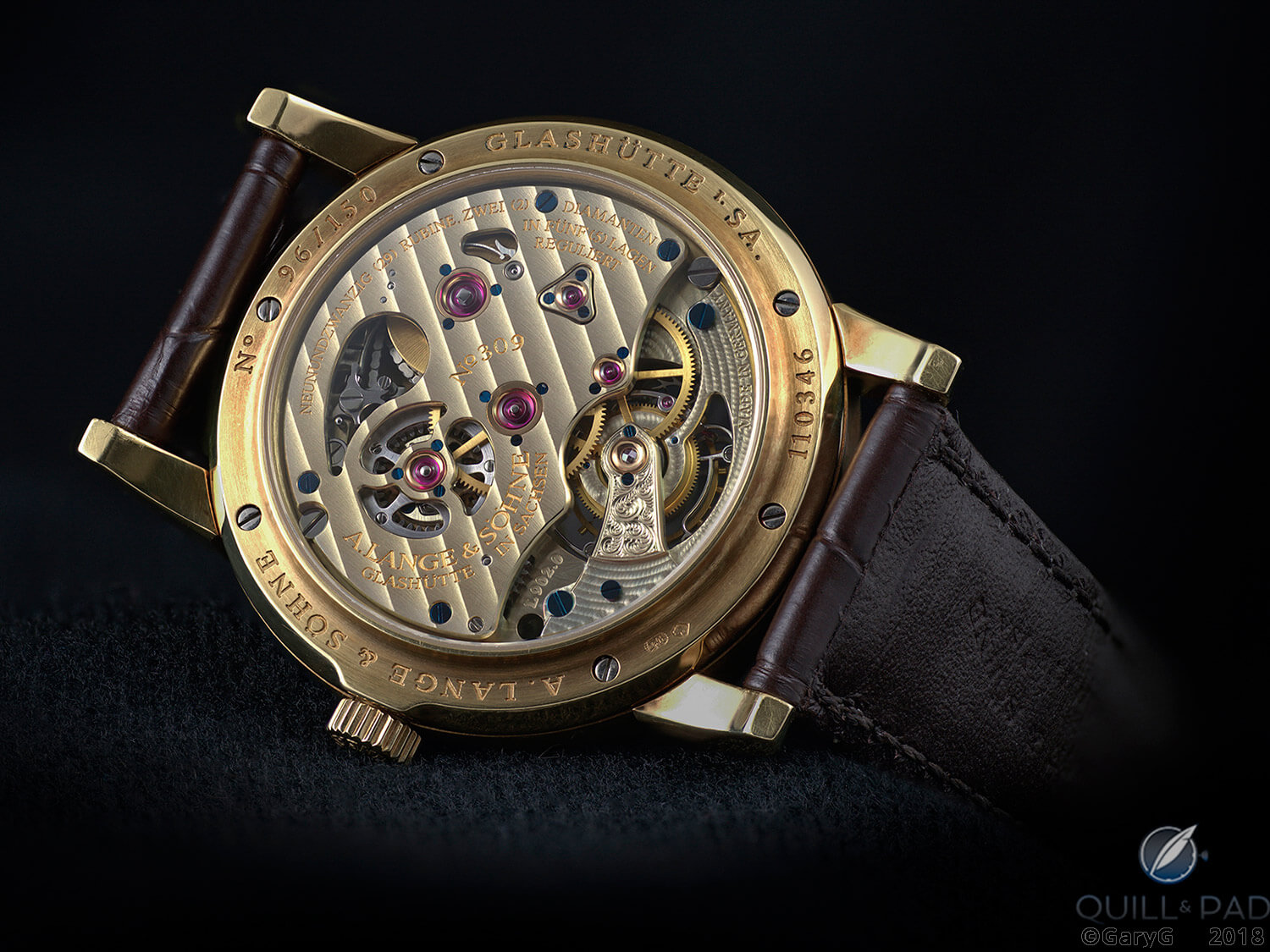
Movement view, A. Lange & Söhne Pour le Mérite Tourbillon
I’m fanatical about image sharpness, and the X1D is the best camera I’ve used on that dimension. In the photo below, it captures all of the fine details of the Patek Philippe Reference 5170P dial and hands in sharp relief without missing a beat on showing the play of light on the dial-side elements and capturing the gradual shift in dial color from blue in the center to black at the edges.
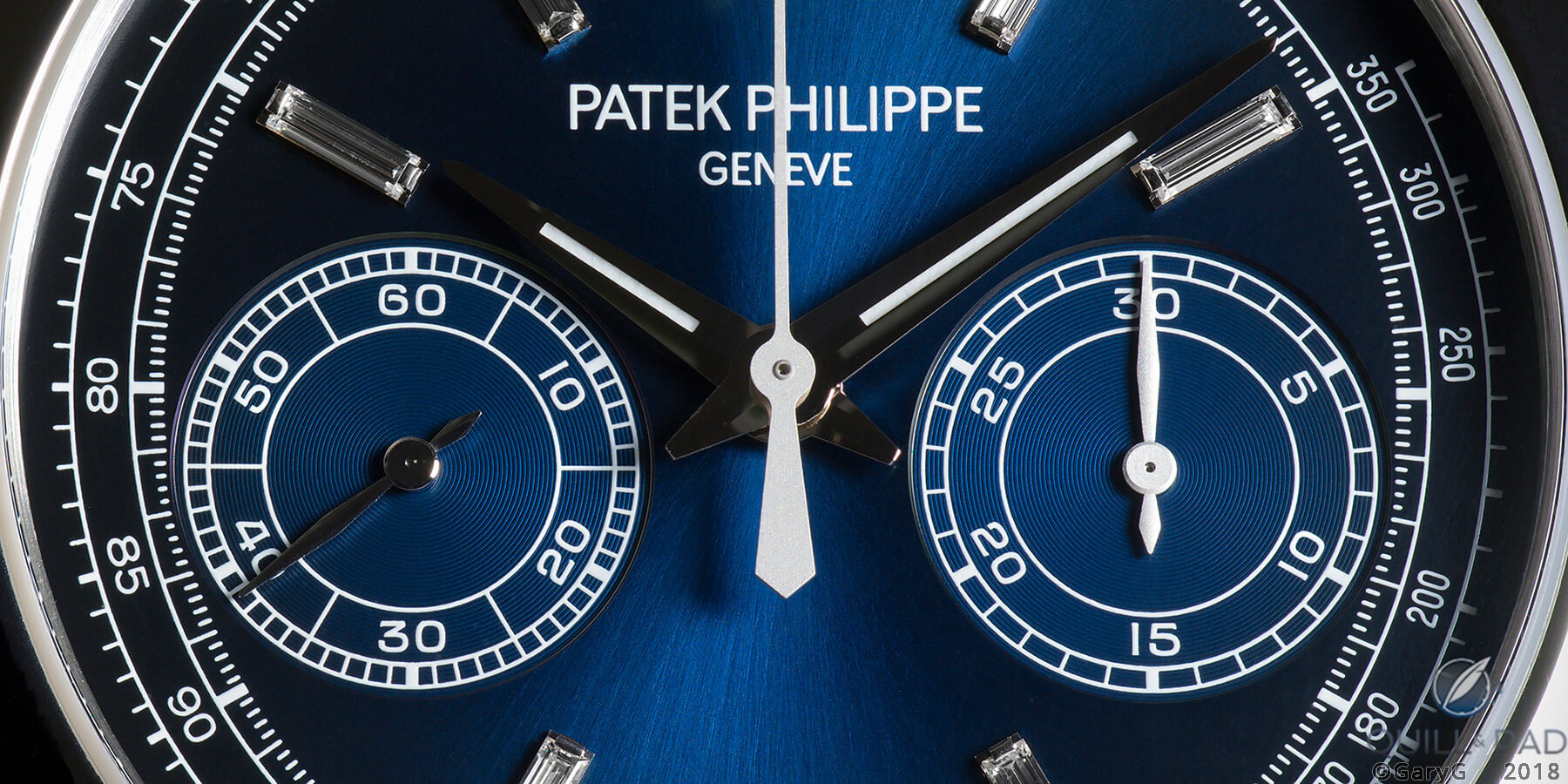
Dial detail, Patek Philippe Reference 5170P
It’s hard to describe, but for me there’s just more “life” in the images from the Hasselblad; I suspect that this comes from its ability to sense subtle differences in light that provide an almost three-dimensional effect as we peer into layered elements in watches. And in its color rendering, which for me is warmer and less clinical than the Nikon’s.
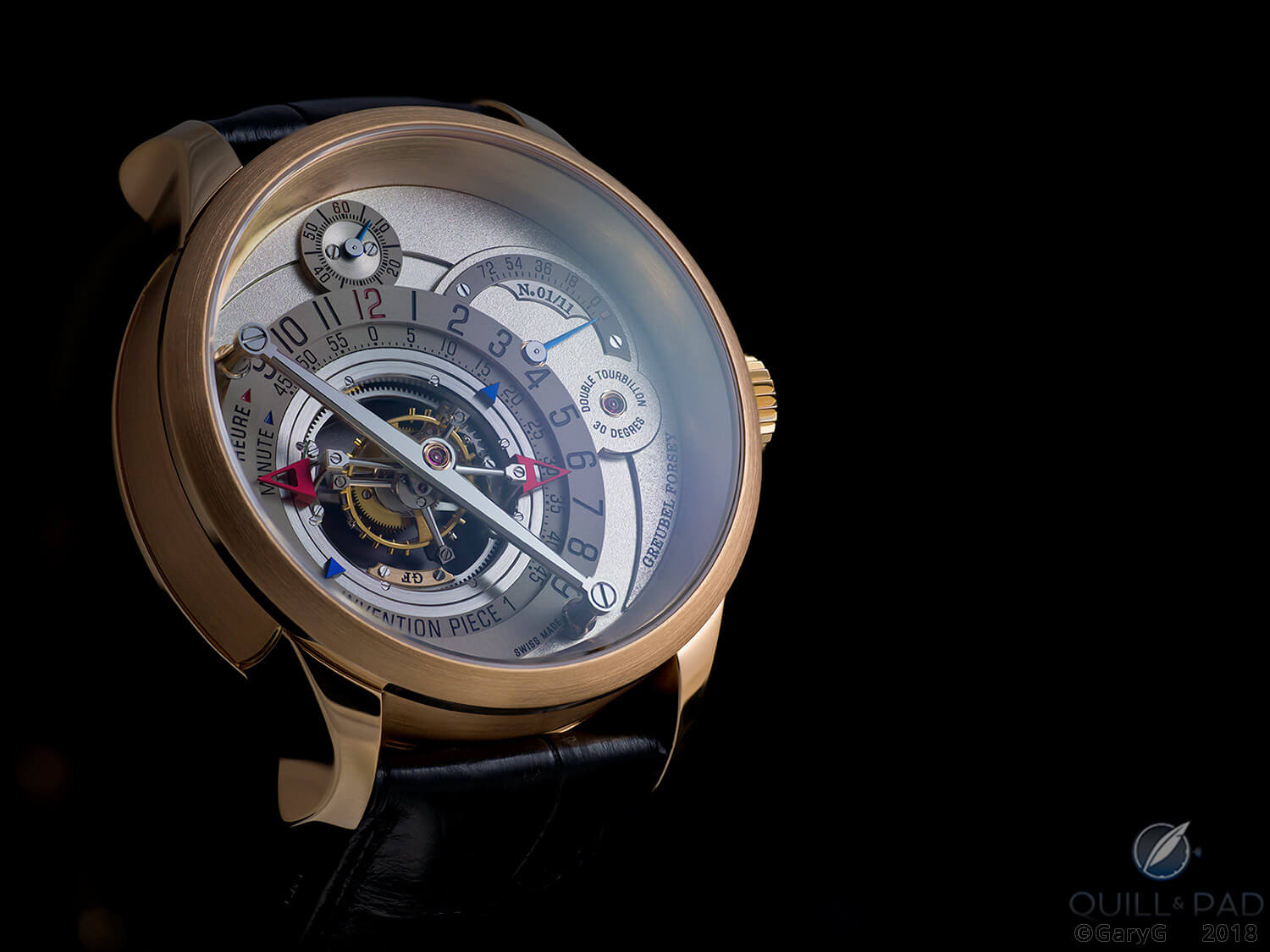
Warmth and depth: Greubel Forsey Invention Piece 1 seen with the Hasselblad X1D
I’d shot (or perhaps I should say “tried to shoot”) the movement of my Voutilainen chronograph several times but had always been bedeviled by the harsh reflections from the rhodium-plated bridges and plates and the swath of pinkish-yellow light thrown on the left side of the movement by the interior of the case’s officer back.
The X1D took it all in stride and gave me an image that is both technically satisfying and (at least for me) emotionally engaging.
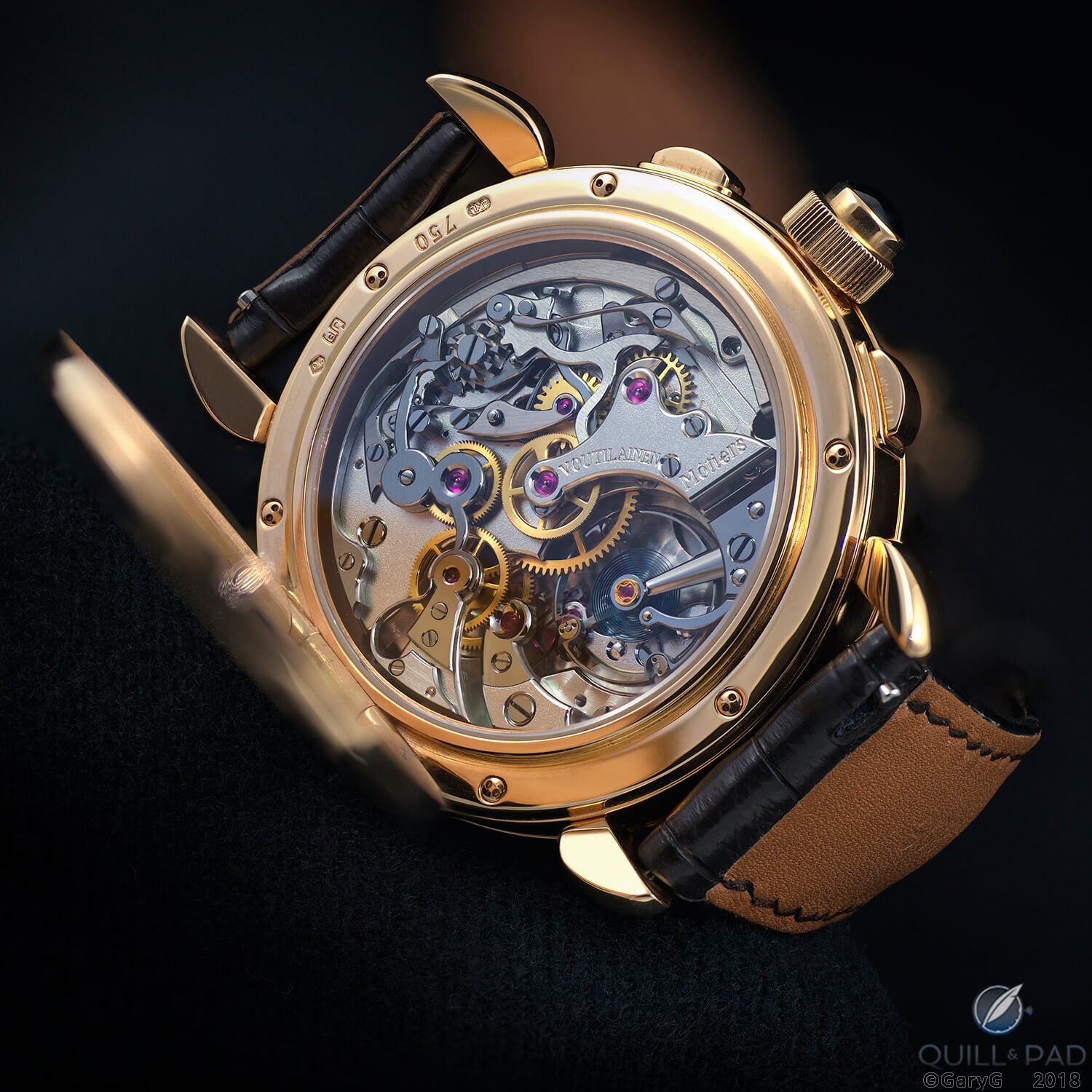
Movement view of the author’s Voutilainen Masterpiece Chronograph II
Shooting a fun watch like Konstantin Chaykin’s Joker becomes enjoyable as well, as you can show off the Joker’s smile without having the tongue and black background look the same while at the same time casting some pleasing shadows on portions of the watch’s bezel.
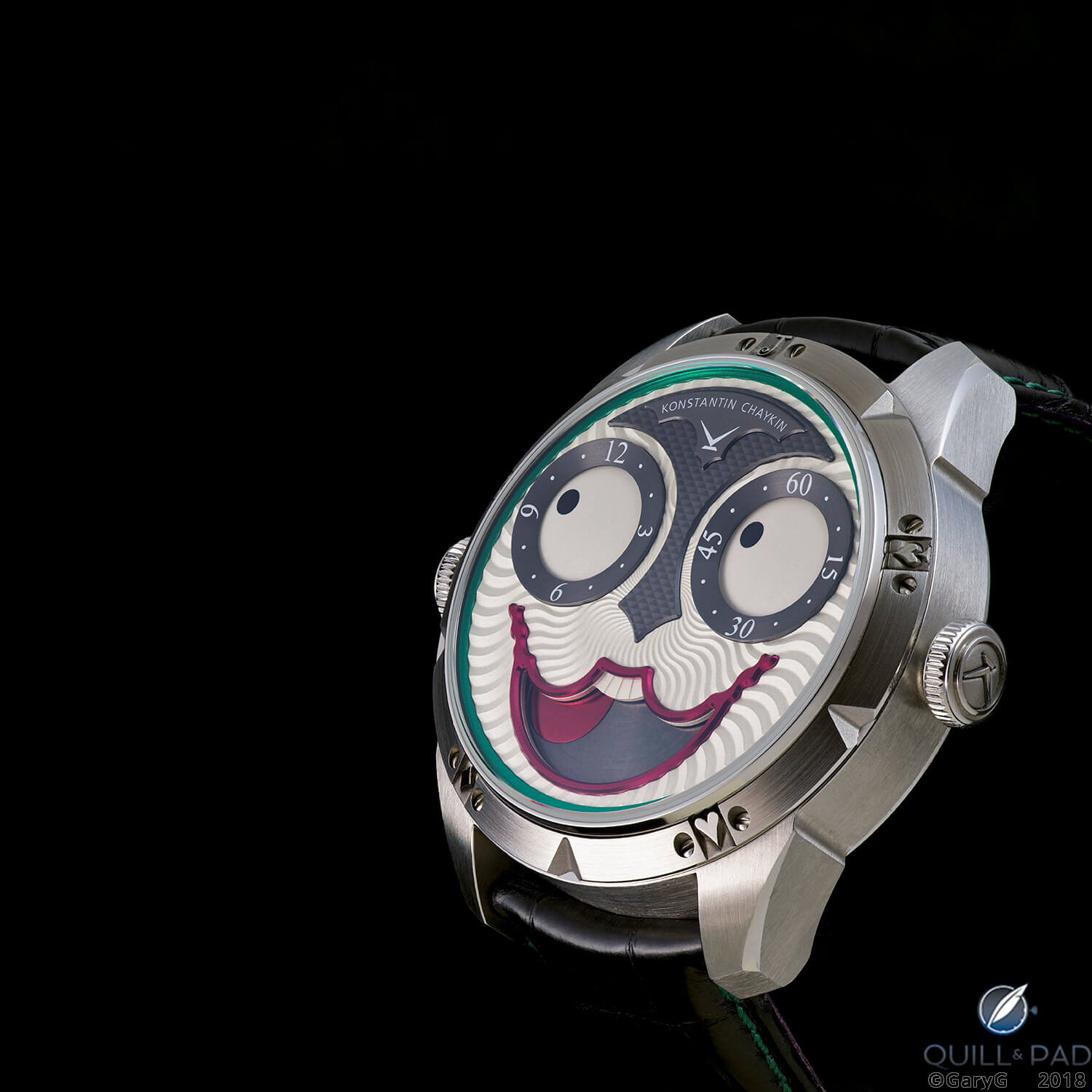
Joker by Konstantin Chaykin
Subject isolation – the ability to draw attention to one feature of a watch with focus and light – is one of the most important aspects of watch photography, and the ability to be highly selective with which part of an image to place in focus is a real strength of a medium-format camera like the X1D.
In the photo below, I’m able to draw attention to the clearly illuminated and sharply focused Patek Philippe logo while still allowing the viewer to get a sense of its surrounding context.
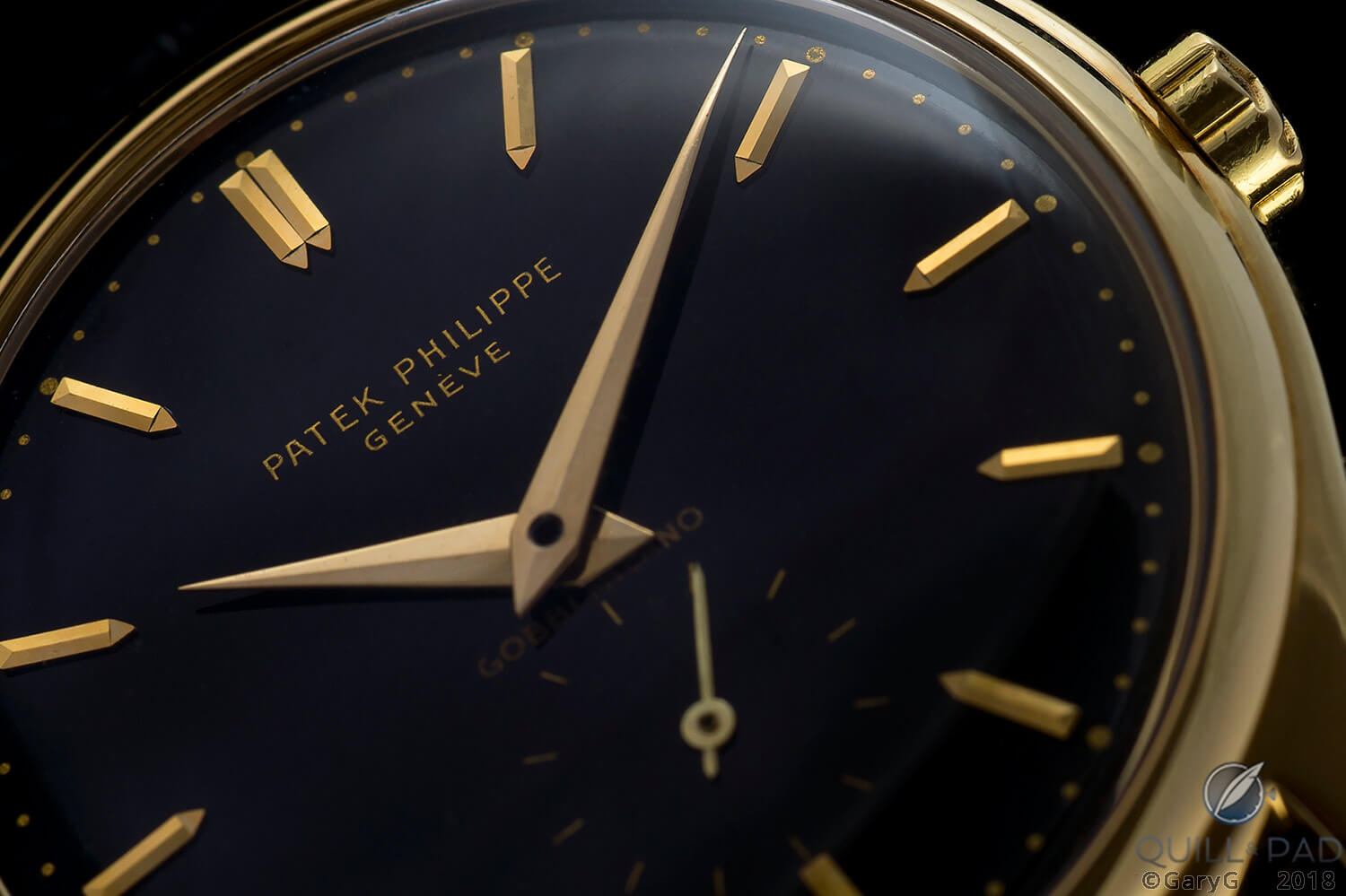
Dial detail, Patek Philippe Reference 2526 in yellow gold with black enamel dial
The perfect camera?
Well, not so fast.
For all of its strengths the X1D can be frustrating at times, and not just because a camera this capable has the ability to reveal your mistakes in excruciating detail.
Getting a shot set up and made is a fussy affair. The Live View function that lets you see what you’re shooting on the screen on the back of the camera while you adjust lights and focus has a relatively short time limit so the large sensor doesn’t overheat. As a result, it seems that just as you’re making a critical adjustment the screen goes black and you need to bump it back to life.
The magnification level of the screen is also lower than the Nikon’s, so making extremely fine focus adjustments is difficult to do, and I’m often left to “focus bracket” several shots in the vicinity of the right setting in order to get one really sharp one.
And while it is theoretically possible to trigger the shutter using an app on your phone, I have real problems finding and keeping a connection between phone and camera. I’ve now gone to pushing the X1D’s shutter-release button and using a multi-second shutter delay to allow the camera to stop vibrating before the electronic shutter operates.
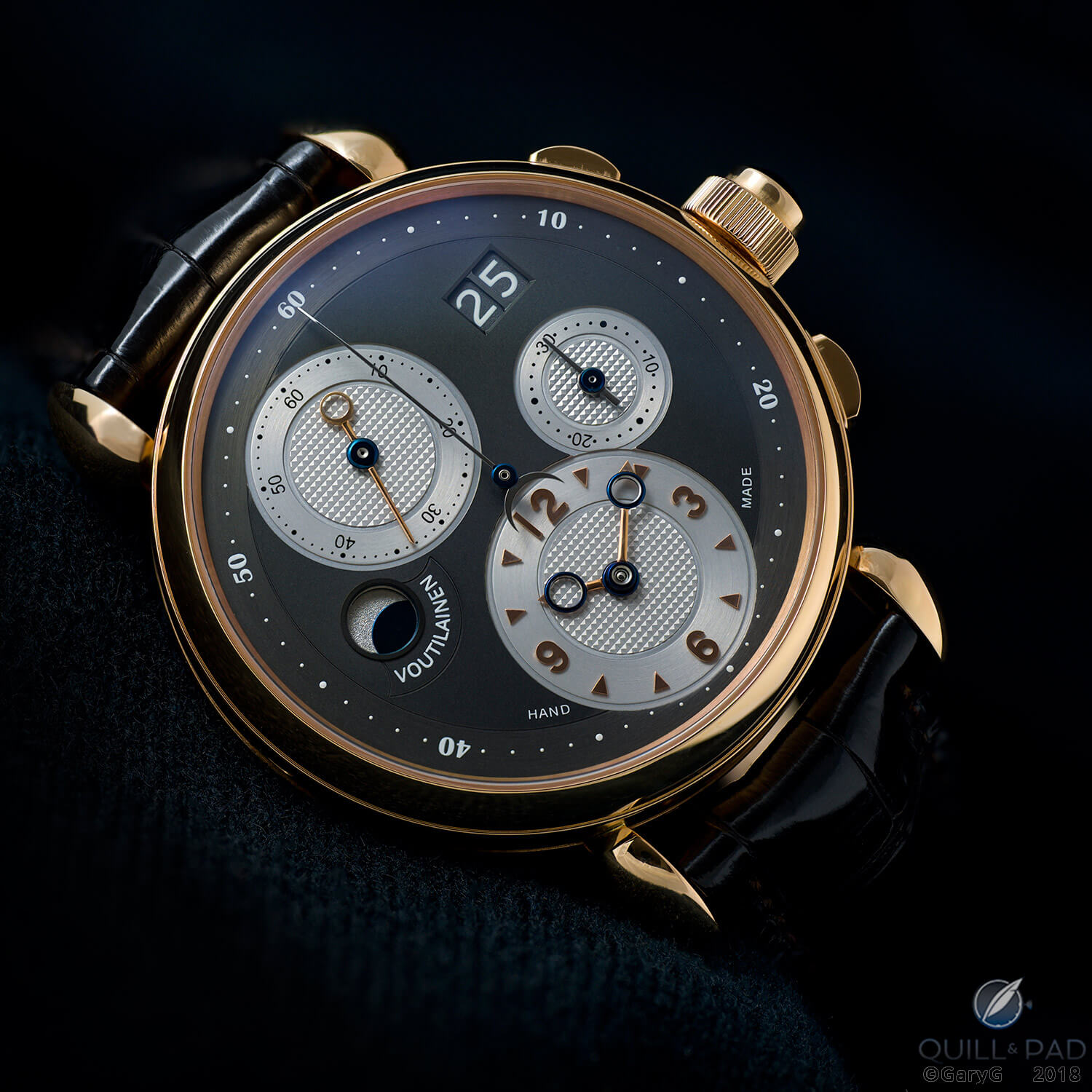
Not easy, but worth it: Hasselblad X1D shot of the author’s Voutilainen chronograph
The very shallow depth of field of the XCD120 macro is great for subject isolation. But it also means that taking any image in which the watch is at an angle from the camera (and you want the entire object to be in focus) requires stacking of multiple shots taken at successively closer distances from the watch and combined using stacking software.
Stacked images can be great, but they do have their limitations, including less distinct shadows and the introduction of visual artifacts and over-sharpening by the stacking software.
Happily, some enterprising folks have recently started producing adapters that allow non-Hasselblad lenses to be mounted to the X1D, and I’ve started using a Fotodiox adapter to attach my trusty Nikon tilt-shift lens to the X1D.
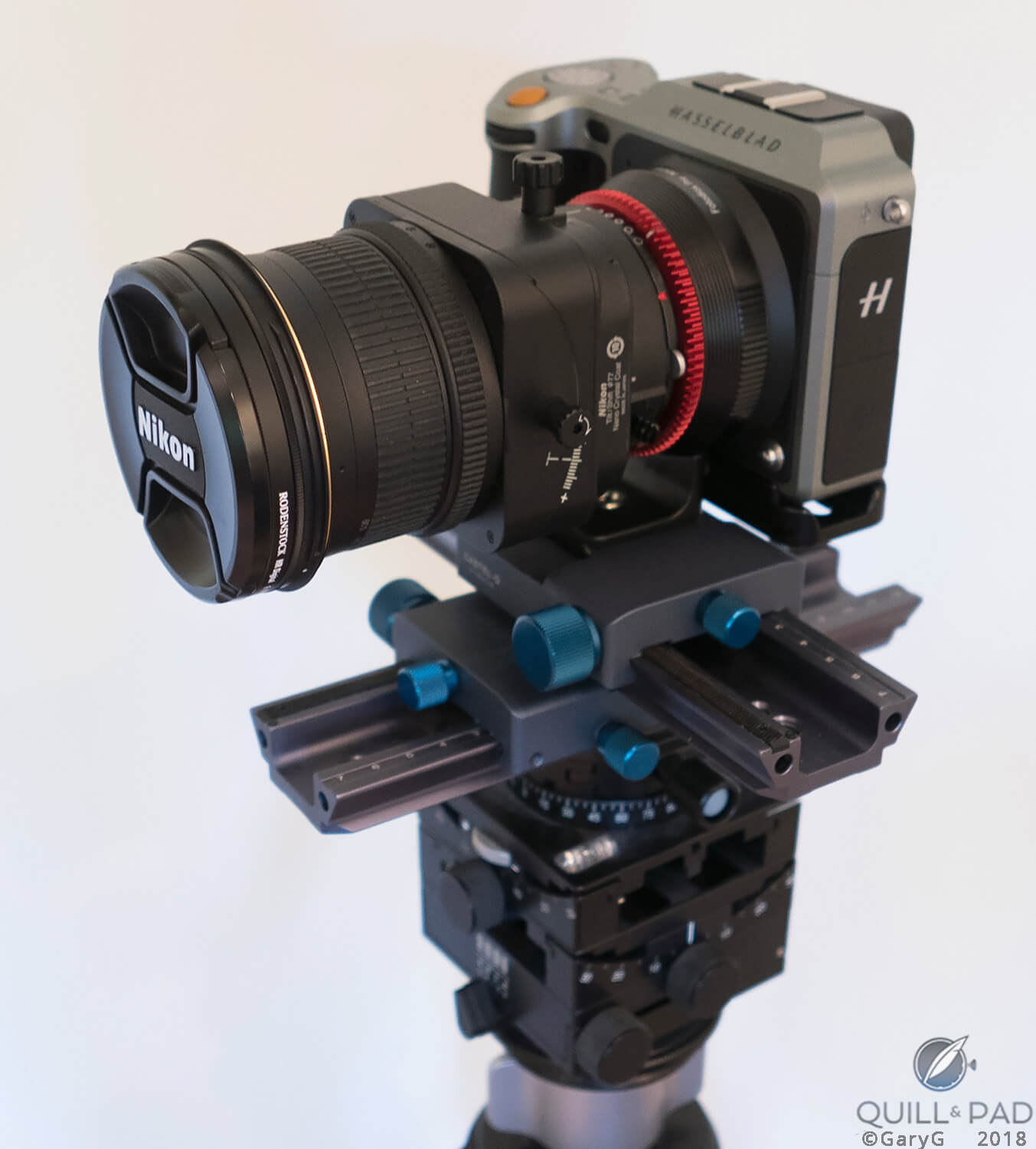
Nikon PC-E tilt-shift lens mounted to the Hasselblad X1D
The “tilt” of the lens allows a watch to be placed at an angle to the camera with all of the depth of field captured in a single shot; while at the limit the Nikon lens is not as super-duper sharp as the Hasselblad macro, the ability to use tilt is such an advantage that I’m sure that I’ll be using that camera-lens combination fairly often, as I did to capture the movement image below of my buddy’s Voutilainen.
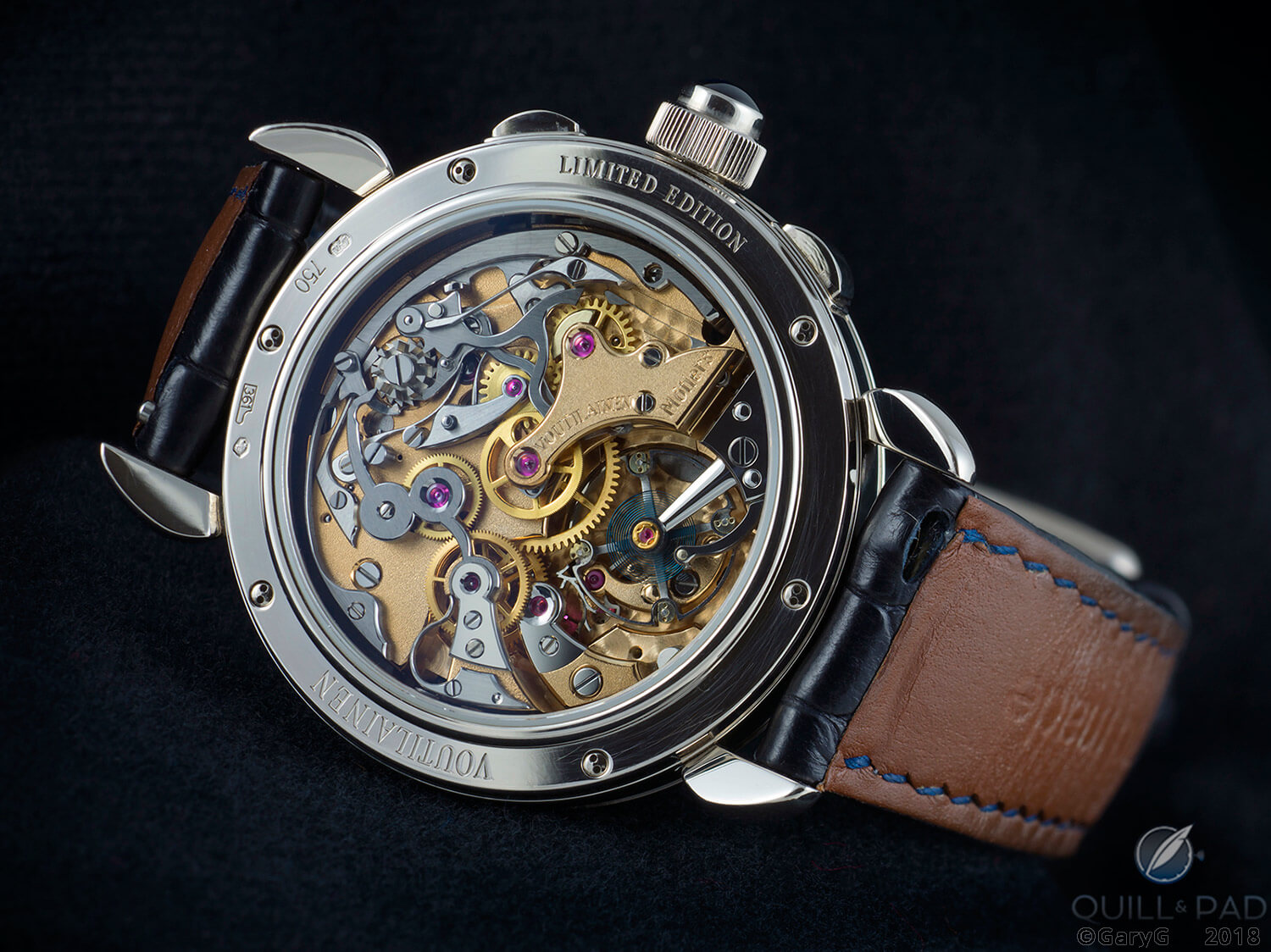
Movement view, Voutilainen chronograph as captured with the Hasselblad X1D and Nikon PC-E 85 mm lens
Final thoughts
What’s the bottom line? I must confess that especially given the expense of the Hasselblad system, I entered into this whole adventure with some trepidation. And as mentioned above, using this camera and lens for macro shooting requires practice and patience – with the occasional muttered curse or two for good measure.
All of that said, for me the ability to go to the next level with my watch photography has made it all worthwhile; the best images this camera is capable of are very, very good indeed. And it brings me real pleasure to be able to capture one or two from time to time and share them with you.
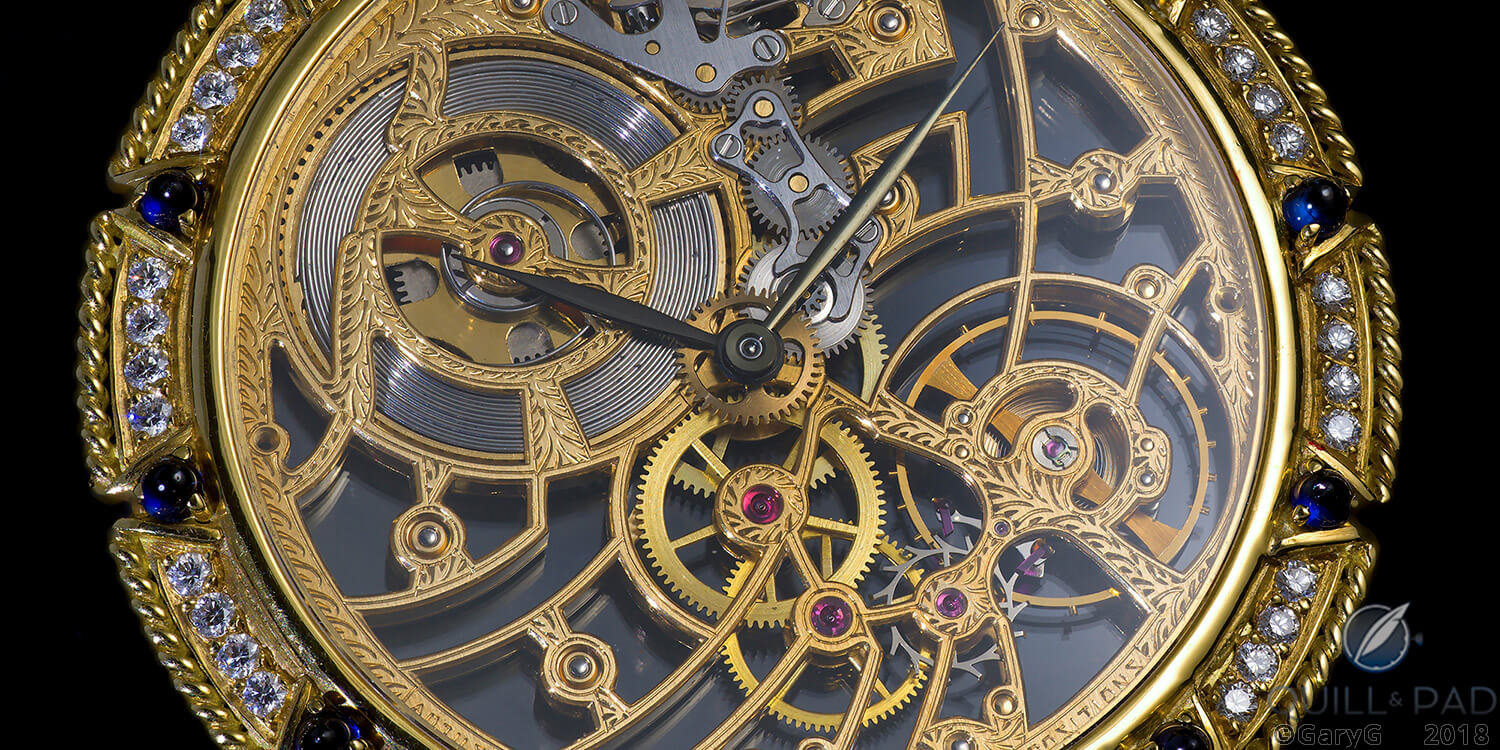
Parting shot: skeletonized Audemars Piguet pocket watch shot with the Hasselblad X1D
For more information, please visit www.hasselblad.com/x1d.
Quick Facts Hasselblad X1D-50C
Sensor: 50MP 43.8 x 32.9 mm CMOS sensor
Image quality: 16-bit color, Hasselblad Natural Color Solution, 14-stop dynamic range
Monitor and viewfinder: 2.36 MP XGA electronic viewfinder, 3.0 inch 920k dot touchscreen LCD monitor
ISO range: 100 to 25600, up to 2.3 frames per second
Current retail price: $6,495 including $2,500 promotional discount at B&H Photo Video (list price $8,995)
Quick Facts Hasselblad XCD 120 mm f/3.5 Macro Lens
Equivalent focal length: 95 mm (35 mm equivalent)
Aperture range: f/3.5 to f.32
Shutter: central leaf shutter, 1/2000 sec flash sync
Maximum magnification: 1:2
Minimum focus distance: 1.4 feet
Current retail price: $4,495
Leave a Reply
Want to join the discussion?Feel free to contribute!



Ok. So I have spent some time pondering on how to respond to this article because there is a lot to say on a number of different angles.
But let’s start with this – one significant problem is that the article seems to be proposing that the X1D is a camera that should be considered seriously for product photography in general, and watch photography in particular.
Nothing could be further from the truth.
This was a camera that was designed from the outset for street photography. And it shows.
Before I delve deeper into this, I would ask one simple question.
Can you find a single professional product photographer that uses this camera for the purpose described in this article?
Gerald, admiring your own watch photos on Instagram, I would much appreciate to learn how the choice of equipment “shows” and what you recommend for such product photography. Myself, I still struggle with a simple Olympus E-M1, but nevertheless would love to read a professsional’s opinion. Thanks.
Hi Bruno –
Firstly, I’m not really a professional in this space (I would define a “professional photographer” as someone who makes the majority of their income from licensing their images to clients – which I do not).
I’ve loosely answered your question in a reply to Gary below (currently awaiting moderation as I type). For a further more detailed response, please don’t hesitate to contact me privately.
Kind regards,
Gerald.
Hi Gerald,
To answer your specific question, I’ve asked around since receiving your comment and the answer is “yes” — in fact, several pro shooters.
But that’s not really the point of my article — the piece expresses my personal view that for me, this camera does under certain circumstances yield results that I consider to be superior to those that I can achieve from other cameras that I’ve used, and that it also adds to my enjoyment of shooting — and as a result therefore has real utility for me based on my shooting style, desired results, and workflow.
One example: given that I shoot the majority of watches against dark backgrounds and also want the details of the straps to be visible, the real-world dynamic range of the X1D is a material advantage for me.
My assumption is that serious shooters, pro and amateur alike, are experienced and mature enough to make their own assessments as to whether the same is true for them or not.
Finally, while I originally bought the camera and its 90mm lens for candid portrait shooting, neither my survey of online reviews nor my discussions with informed users support your contention that this camera was designed specifically for street photography or to the exclusion of other photographic disciplines.
All best, Gary
Hi Gary –
Thanks for taking the time to reply.
I’m just going to preface my comments by quoting my original question for context.
“Can you find a single professional product photographer that uses this camera for the purpose described in this article?”
It’s certainly eye-opening for me that you have found several pro shooters who are doing exactly that.
I’d be very interested to know who they are, to view their work, and discuss with them why they find it the best option, because I just don’t see it. Quite possibly it is a lack of understanding on my part.
Perhaps you’d like to invite them to share their experiences here? If they are not comfortable sharing their portfolios and experiences in public, I’d be more than happy to discuss the matter privately with them.
The camera is not designed for watch product photography, it’s as simple as that. And your article explicitly highlights its considerable failings in this area –
“Getting a shot set up and made is a fussy affair. The Live View function that lets you see what you’re shooting on the screen on the back of the camera while you adjust lights and focus has a relatively short time limit so the large sensor doesn’t overheat. As a result, it seems that just as you’re making a critical adjustment the screen goes black and you need to bump it back to life.”
“…so making extremely fine focus adjustments is difficult to do, and I’m often left to “focus bracket” several shots in the vicinity of the right setting in order to get one really sharp one.”
The camera is small and lightweight, making it great for handheld street/lifestyle/candid photography or for those who like to hike around Yellowstone capturing landscapes without breaking their back.
“But that’s not really the point of my article…”
You introduce your article stating the following –
“…it is nonetheless true that a practiced photographer can achieve different (and in my view, better) results with a camera that’s *ideally suited* to the objective and situation than with more rudimentary equipment.”
The clear implication here is that the camera is *ideally suited* to watch product photography, but in your article you conflate the camera *system* with the sensor inside the camera. These are two totally separate things.
Is it true to say that the sensor in the camera is great for this kind of work? Absolutely.
But when that sensor is in the X1-D, and within the X1-D ecosystem? No.
In your instance, you have resorted to third party adapters and third party lenses to be able to use tilt. Sure, I suppose one could stay “in-house” use the Hassy HTS 1.5 adapter, along with the XH adapter, and then one of the compatible HC or HCD lenses, but stack up the cost of that…
And of course, when you are doing product photography, the camera is going to be in a studio, and on a tripod. All the benefits designed into the X1-D system that make it a great camera for carrying around in the hand – its entire rationale for existing – become irrelevant.
It’s also worth pointing out at this juncture that the 120mm “macro” lens actually only has a maximum magnification of 1:2. I am genuinely perplexed that any professional photographer in this space would buy into a system that offered no native ability to shoot with lens movements and a maximum magnification of only 1:2.
Which is probably why Hassleblad themselves do not market the camera for product photography usage at all. No shots of it being used for product work, no sample images provided of product work.
https://www.hasselblad.com/x1d/
I doubt a single Hassleblad dealer on the planet, when asked “what can you recommend from your range for product photography?”, would reply “Oh, the X-1D.”
So onto the sensor…
The sensor is, absolutely – like the vast majority of medium format sensors ever made – fantastic. I don’t think any MF sensor from the past 5 years or so would have any difficulty whatsoever pulling out the details of a black strap against a black backround.
So. Would it be technically possible – and actually practical – to use the X1-D purely for the capabilities of its sensor, and mount it on a “proper” studio camera such as an Arca-Swiss, Sinar, or Linhof, or perhaps with a cheap and simple rail and bellows system like those Novoflex offer?
Well, possibly – but I honestly have no idea. I’ve not looked into it. You’re still not going to get away from the issues that you raised, although possibly some would be negated if you were shooting tethered – with the back I use I am able to nail focus to within 500 microns using tethered live view (maybe that’s something worth investigating with the X1-D even natively yourself?).
Perhaps one of the pro shooters you contacted could chime in here with some information – I’m sure at least one of them must have looked into this option, because it simply has to be a requirement for anyone shooting watches professionally to be able to go beyond 1:2 magnification, and/or have a system that provides movements.
But if you want to use a MF sensor on a camera that is more suitable for the type of work shown here, then of course you are not limited to the X1-D. There are plenty of digital backs available that can be purchased to take advantage of those great sensors, and then mounted on a camera system more suited to the requirements.
That then would give the photographer (pro or amateur alike), a system that truly is “ideally suited” for the purpose described in this article.
Kind regards,
Gerald.
Hi Gerald —
Thanks for taking the time for this thorough response — you make some excellent points, and I concur in many of them.
One key point in response: my comment at the outset of the article about the value of an “ideally suited” camera in the hands of an expert shooter was a general commentary meant to address what I see as two common misconceptions: a) Good images are the result of good cameras, and b) Since a good shooter can make a good image with just about any camera, it’s useless to search for even better options once your setup is “good enough.” I didn’t mean to imply that the X1D is in fact “ideally suited” to this task — if that was the obvious implication to you, I apologize for any imprecision in my writing that created that direct link.
As further evidence that I don’t believe that the X1D as a system (I like your distinction between sensor and system here) has achieved watch shooting nirvana, I’ll only point to my later critiques of the camera that you correctly quote in your response! However, in day to day use I’m finding that I pull out the Hassy almost all of the time and leave the D810 on the shelf. What that’s telling me is that when it comes to making tradeoffs and getting closer to the “ideal” for me, IQ (defined in my own personal way in terms of resolving power, subtle rendering of light, and color fidelity) is much more important than other criteria (many of which relate to ease of use). On the above, one area in which the X1D does excel as a “system” is in color fidelity — that huge calibration file that takes so long to load each time one fires up the camera does result visibly in true colors that require very little correction to make the photo look like the watch.
I like your suggestion of tethering — I may try that at some point although the setup of my desktop studio makes it tough to isolate the tent from the light blowing off my big monitor, so will require some fiddling.
The 1:2 limitation has been mentioned by others, but once you net out the sensor size advantage I find that the size of the watch itself in pixels on an X1D image is still larger than on the D810, so while it would be nice to have absolutely gigantic uber-res files like the ones you generate the X1D still wins over the D810 for me on that criterion. At some point I may strap an extension tube onto the Nikkor PC-E and the Hassy just to see what happens — it may be a vignetting festival but I won’t know until I try and the perspective control lenses do have a fairly large image circle.
Finally, I’m not going down the trail of extending the discussion about which pro shooters, why, and so on — that’s your thread, not mine, and I’ve made enough inquiries to satisfy my curiosity on the topic so will be moving on.
Thanks again for the informative and civil discourse — always a pleasure to exchange views with you.
Best, Gary
Some great shots and a fascinating tale! It’s difficult to be sure, but I get the impression that the Hasselblad’s advantages remain even when the images are presented on a computer screen at fairly low resolutions (they must be amazing if printed on quality papers), feeling a bit like the difference between vinyl records and CD’s!?
It does seem like the CD/vinyl difference, or even sometimes the difference between photography and painting — the subtlety with which this camera captures light gradients is hard to believe.
And yes, I do often wish that online viewers of these downsized and compressed images could see what I see in full size on my home monitor!
Thanks, Gary
Gary. You write well, your articles are interesting, and you have many nice things. But try imagining your readers don’t all share your boundless wealth and focus on the passion we share rather than the means we don’t.
Have to agree here. We aren’t all blessed with this amount of disposable cash.
However beautiful photos and a great camera, thanks.
Please see my response to Mark — thanks!
Hi, Mark and Milhouse —
Thanks for the comments — at the very beginning here a few years ago I invited readers to let me know if I veered off into “look at me — I own stuff” land, so I do appreciate your taking the time to post remarks here.
I have to confess that based on your input I’ve re-read this article a couple of times and I’m not really seeing how the bulk (or even very much) of the commentary is about the means rather than the passion. I do mention that I had some trepidation about buying the Hasselblad given its cost, but for me that was a legitimate concern, not a show-off move. Otherwise I’m reading this piece as a commentary on how this camera works for me — sorry if it comes off otherwise for you, and thanks again for your remarks.
Best, Gary
Enjoyed your article Gary!
Maybe one day you could do a follow up comparing focus stacked images from the Hassie and the D850 using the same lens for watch photography?
Good idea, Harry! I’ll put that one on my list as I’m intrigued by your thought. Thanks for taking time to comment!
I have a simple question… While all your shots are, in my opinion at least, artistic when I view a watch in ant artical about it I want at least one picture front facing with no angle so I can see the watch… I would also like the same for the back of the watch and if possible the inner workings… This seems to be missing in most of the watch articles I read. I realize, being a little of a photographer myself, the technical issues of the reflections in the crystal and the difficulty of lighting that sort of shot… But I would think that anyone that was passionate about watch photography would take the time to master that… So with thatong winded wind up… WHY do I not see that? Is there something I am missing about watch photography?
Hi Ron — excellent question! I usually do try to include at least one straight-on shot of the dial side of each watch I feature, but will pay better attention to this (as well as direct shots of the back sides of watches) in future articles. As you say it’s not trivial to get a good straight-on shot, but not so difficult once one has a decent level of experience — perhaps most shooters don’t see that angle as particularly “arty” but I certainly understand why you want to be able to evaluate a watch with direct looks!
Best, Gary
Great work, thanks for writing this up. Does the Nikon lens vignette when used for close focus? The image circle of a lens gets bigger as the lens is focused out. At 1:2 the image circle should be sufficient to cover the larger sensor. But I wonder if the lens housing might crop the image circle. Have you considered a bellows with an enlarging lens?
Thanks
Totally agree with you. Excellent works!
My jaws dropping just watching your photos in my 12.9” iPad. I’ll bet even iPhone would be enough to recognize your works. It’s not equipment, more less weather u have the EYES or not. Enjoyed ur works. Don’t be discouraged by people who just don’t see it. My problem is simple. The Hassy look and the Leica look cost so much. Even if I get those in my hands, I do not believe I can photograph that good. I look forward to find more of your amazing works. Thank you, Thank you. Thank you. Made my day. Jin
Firstly – I cannot believe that someone has said this camera was designed for “Street Photography”. This is one of the most ridiculous things I have ever seen written on the Internet. It is a studio camera, for premium quality images of still subjects like portraiture, fashion, landscapes, travel, products and so on. I congratulate Hasselblad on putting the guts of a H series camera into a beautiful, compact design. I own this camera and adore it.
Second – Street Photography quite frankly is nothing, it’s just hipsters taking empty shots and congratulating each other on instagram. Documentary photography on the other hand…